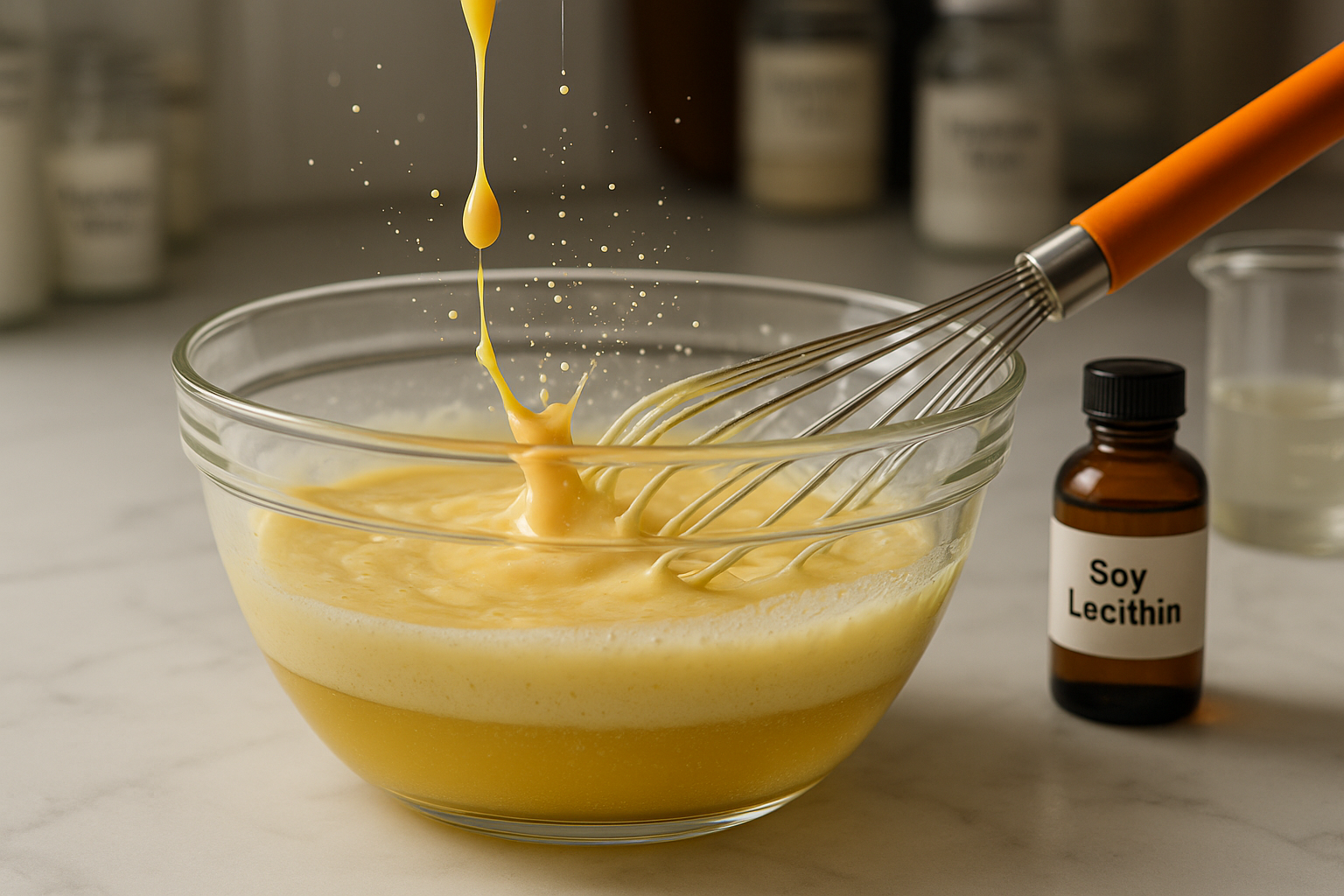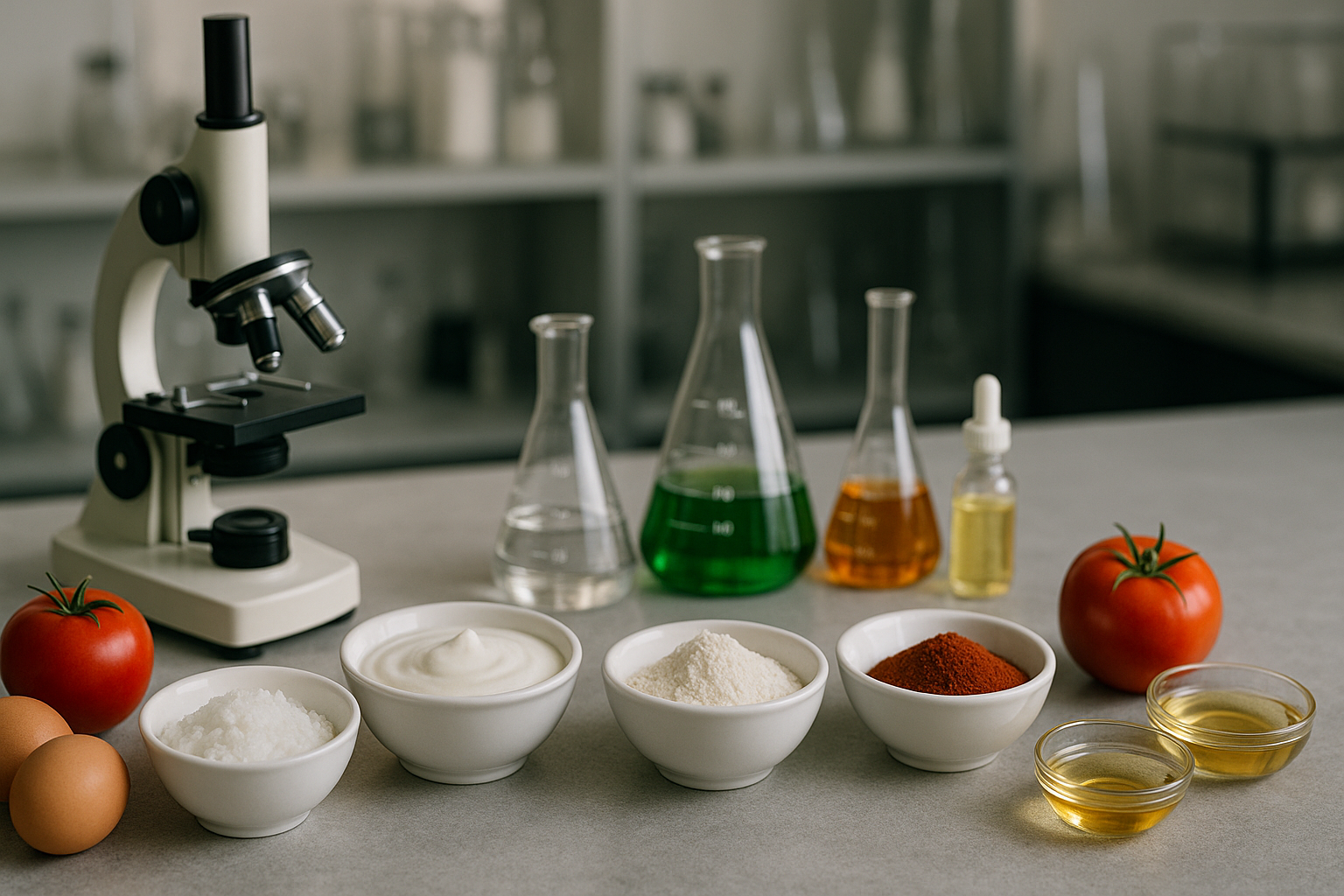
The Hidden Chemistry of Everyday Foods: The Story of Emulsifiers
SUBSCRIBE TO OUR BLOG
Promotions, new products, and recipes.
Few people pause to consider why mayonnaise never separates, why ice cream feels creamy, or why a chocolate bar snaps with such even gloss. Yet all of these depend on a quiet molecular diplomat — the emulsifier.
What Exactly Is an Emulsifier?
In food science, emulsifiers are amphiphilic molecules — they possess both water-loving and oil-loving ends. When mixed into a blend of oil and water, they migrate to the boundary, orienting one end toward each phase. This reduces interfacial tension and prevents droplets from coalescing, keeping mixtures like sauces, dressings, and creams smooth and stable (FoodIndustry.com).
The most familiar household example is lecithin, a natural emulsifier found in egg yolks, sunflower seeds, and soybeans. It’s what keeps mayonnaise glossy and consistent — proof of how oil and water can cooperate under molecular negotiation.
Where Emulsifiers Come From
Most commercial emulsifiers are derived from edible oils and fats. Mono- and diglycerides (E471), for example, are created by reacting plant-based triglycerides with glycerol under controlled heat and catalysts. Lecithin is recovered during the degumming step of soybean-oil refining, or the pressing of sunflower seeds. These ingredients appear in everything from chocolate and margarine to bread and beverages (PMC: Food Emulsifiers Review).
The Common Faces Behind the Label
Here are some of the most frequently used food emulsifiers found on ingredient lists:
-
Lecithin (soy, sunflower or egg, E322)
-
Mono- and diglycerides of fatty acids (E471)
-
Polysorbate 80 (E433) and Polysorbate 60 (E435)
-
Sorbitan monostearate (E491)
-
Sodium stearoyl lactylate (E481)
-
Glycerol monostearate (GMS)
-
DATEM (E472e)
-
Carrageenan, guar gum, and xanthan gum
A full compilation of industrially approved emulsifiers is cataloged by the Alliance to Cure.
The Double-Edged Role of Emulsifiers in Health
While emulsifiers revolutionized modern food production, new research suggests they may also interact with the gut in unintended ways.
A controlled human feeding trial conducted by Chassaing et al. found that consuming the additive carboxymethylcellulose (CMC) for just 11 days altered gut microbiota diversity, reduced short-chain fatty acids, and increased post-meal abdominal discomfort (PubMed). Similar findings appear in animal studies, where polysorbates and CMC disrupt the intestinal mucus barrier and trigger low-grade inflammation (Microbiome Journal).
Meanwhile, epidemiological data from the French NutriNet-Santé cohort linked higher overall intake of processed foods containing emulsifiers with increased risk of type 2 diabetes and cardiovascular disease (Verywell Health).
Regulatory agencies like EFSA and the FDA still classify most emulsifiers as safe within approved limits — emphasizing that the new findings show correlation, not causation. Still, dietitians and food scientists alike suggest moderating exposure by limiting ultra-processed foods.
Real-World Implications
In practice, emulsifiers are used at very low levels — typically 0.2 % to 0.5 % of a formulation — just enough to keep sauces smooth or doughs uniform (PMC Review). Natural options such as lecithin, guar gum, and pectin remain preferred for “clean label” foods.
For consumers, reducing emulsifier intake often simply means eating closer to the source: whole fruits, vegetables, plain dairy, and homemade dressings where egg yolk or mustard serve as natural emulsifiers.
The Gut Connection
The gut microbiome — the body’s inner ecosystem — appears particularly sensitive to emulsifiers. Studies show that some synthetic agents thin the intestinal mucus layer and alter microbial populations, potentially encouraging low-grade inflammation. A 2025 Gut journal paper reaffirmed these findings, describing distinct microbiota changes in healthy adults consuming CMC (Gut BMJ).
Conversely, natural emulsifiers like lecithin have shown no such adverse effects and are widely considered safe at normal dietary levels.
The Balanced View
Emulsifiers are neither purely villains nor heroes. They make food production possible at scale — without them, most packaged foods would quickly separate or spoil. But they also remind us that technological convenience sometimes outpaces biological adaptation. As scientists continue to study their long-term health impact, moderation and ingredient awareness remain the safest paths.
FAQs About Emulsifiers
1. Are all emulsifiers harmful?
No. Natural ones such as lecithin, guar gum, and pectin have long safety records, whereas synthetic types like CMC or polysorbate 80 show microbiome effects in lab and human studies (PMC11190199).
2. Can avoiding emulsifiers improve gut health?
Possibly. A clinical trial in Crohn’s disease found a low-emulsifier diet tripled the odds of symptom improvement compared to a standard diet (MD Edge).
3. What foods naturally contain emulsifiers?
Egg yolks, soybeans, and many nuts contain lecithin — a natural emulsifier found in whole foods.
4. How can consumers identify emulsifiers on labels?
Look for E-numbers such as E322, E471, E472, or terms like mono-/diglycerides, polysorbate, or cellulose gum.
5. How much emulsifier do manufacturers typically use?
Usually 0.2–0.5 % by weight, just enough to maintain stability.
6. Can emulsifiers cause bloating or digestive discomfort?
In the CMC feeding study, participants reported more bloating and abdominal discomfort than those on the control diet (PubMed 34774538).
7. Do emulsifiers offer any nutritional benefit?
No; they serve a functional, not nutritional, purpose.
8. Are emulsifiers linked to acne or skin issues?
No credible research connects dietary emulsifiers directly to acne. Skin responses are more related to hormonal and glycemic factors.
Conclusion
Emulsifiers illustrate food chemistry at its most ingenious and controversial. They hold oil and water together, deliver sensory pleasure, and keep the world’s food supply stable. But like many modern conveniences, their overuse may come at a physiological price.
For the mindful consumer, the solution isn’t fear — it’s balance: choose foods made with natural stabilizers such as lecithin, guar gum, or pectin when possible, minimize ultra-processed products heavy in synthetic emulsifiers, and remember that the smoothness on your spoon is the result of chemistry working — sometimes too well — behind the scenes.

|
About the Author Ed is the founder of Cape Crystal Brands, editor of the Beginner’s Guide to Hydrocolloids, and a passionate advocate for making food science accessible to all. Discover premium ingredients, expert resources, and free formulation tools at capecrystalbrands.com/tools. — Ed |
Enjoyed this post? Subscribe to The Crystal Scoop
Food-science tips, ingredient know-how, and recipes. No spam—unsubscribe anytime.
- Choosing a selection results in a full page refresh.



